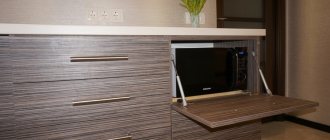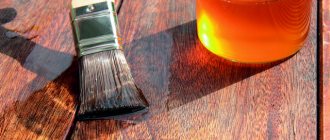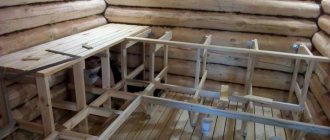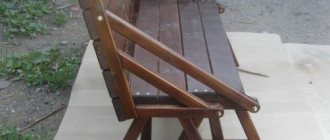Types of benches for baths
Among the models of bath benches, there are portable and stationary options. Their sizes directly depend on the area of a particular room. In most cases, the parameters of the benches are 60-70 cm in length. When making multi-tiered structures, the distance from the ceiling surface to the top point of the bench should be within 1.2-1.3 m.
Often portable structures are smaller in size compared to stationary varieties. Choose a bench for a wooden bath taking into account its purpose, the size of the room and the expected number of people. Benches are distinguished by type of construction:
- Single-tier, characterized by mobility and ease of use. This option is more suitable for small steam rooms. The benches do not take up much space and can be easily moved to the desired location. The bench can be taken out into the open air to dry without any problems or for carrying out repair work on them. There are flat and angular models; they are also good to use for the locker room. Even home craftsmen can make such a wooden bench; moreover, it does not cause much trouble in maintaining it.
- Two-tier, used in spacious baths. They are mounted along blank walls where there are no windows or ventilation holes. You should also pay attention that when installing the bench it is not very close to the stove, otherwise there is a high probability of burns. To access the second tier, a special ladder is used.
- Three-tier, installed mainly in steam rooms. On the highest bench, the visitor has the opportunity to be exposed to high temperatures. The middle tier is made stationary, and the rest are made mobile. The main thing is that the distance between all tiers is at least 1 m. The dimensions of the lower bench are up to 60 cm in width and up to 95 cm in length, the middle and upper tier can be made in larger sizes.
- Stepped, where the lower tier acts as a step. You can stand on it and use it as a seat. So that an adult can lie down on the bench, the tier is made in larger dimensions.
Thanks to the variety of wooden benches for a bath, choosing the most suitable option will not be difficult. It is important to use high-quality material and adhere to manufacturing technology.
Types and dimensions
The model and parameters are selected depending on the purpose and installation location of the structures. There are standard sizes of wooden benches for a bath:
- Bench for lying down. The height of the product reaches 50 cm, width - 90 cm. As for the length, 150 cm is enough for two people. If the number of vacationers is larger, another 60 cm is added for each of them.
- For sitting. The width of the structure is 40 cm. Such models are equipped with a backrest, so their height varies from 50 to 110 cm.
- For the sauna. Products with a width of 60 cm are optimal. The height will be the same as that of benches intended for sitting.
Types of wooden benches, their features, shapes and sizes
There is another type of bath benches - for the steam room. The surface length reaches 180 cm. The following types of products are distinguished:
- Single-tier. The sauna bench is suitable for any small space. Most often, this design is mobile.
- Two-tier. Installed in spacious steam rooms, designed for people of tall or average height. You can climb to the second level using an attached ladder.
- Three-tiered. Installed in large baths with high ceilings. The optimal distance between the lower and upper benches is 100 cm.
- Stepped. Used in small steam rooms. You can lie down on the upper bench; the lower bench is used for sitting or as a support when climbing onto the upper tier.
Multi-tiered benches are ideal for installation in a steam room. With their help, vacationers will be able to choose the optimal temperature regime for themselves. It is better to install a small mobile bench without a back in the dressing room or wash room.
When installing structures with several tiers, experts recommend making the upper levels removable and the lower ones fixed.
Single-tier
Bunk
Three-tier
Stepped
Wood requirements
To make a bench for a bathhouse with your own hands, you need to take a responsible approach to the choice of wood; it must meet the following requirements:
- have a high degree of density, otherwise the product will simply crack during use;
- have a low level of thermal conductivity, otherwise when heated the material will pose a serious danger to the health of the visitor;
- have sufficient resistance to moisture so that the service life of bath furniture is longer.
As for the sauna benches themselves, all wood used (bars, boards) must be carefully sanded. For these purposes, sandpaper of different grain sizes or special machines are used. All existing corners must be rounded. In addition, bath furniture should have high strength characteristics and withstand the weight of several visitors, not just one.
To impregnate wood, it is not advisable to use synthetic-based compounds, which release toxic substances at high temperatures. To treat the bench, it is better to purchase natural impregnations.
To prevent damage to furniture due to high moisture, you should not sew up the space under the bench - this way the quality of drying the material will be much higher. A gap of 10 cm should be maintained from the wall to wooden furniture. It is not recommended to use paints and varnishes for processing interior items.
Making a wooden bench
Bath bench assembly diagram
This part is necessary for use as a replacement for the lower part of the shelf, footrests, basins and buckets.
To make a bench with your own hands you need:
- cut the block into several 40 cm pieces (future supports);
- transverse posts 60 cm long are cut out from another block;
- nail the supports from below, and attach the base for the seat on top, formed from boards 1 m long;
- cover the base of the bench with wooden boards, leaving 1 cm gaps;
- coat the finished furniture with an antiseptic containing vegetable oils.
Do-it-yourself bathhouse bench: photo
Since wood is a natural and environmentally friendly material that is absolutely safe for human health and does not emit harmful particles at high temperatures, it is actively used for the manufacture of bathhouse furniture. To make it easier and simpler to decide on a bench for a steam room, the most common options are presented below.
Additional furniture for the bath: hanger, shelf and headrest
You can use leftover lumber to create hangers, shelves and headrests.
The hanger is made as follows:
- Wooden slats are given the required shape and length using a jigsaw.
- The boards are connected to each other with furniture screws.
- The accessory is treated with stain, after which it dries, varnish is applied.
- The hooks are screwed using small self-tapping screws.
The shelf is located in the washing room. It is built in this order:
- 2 boards 0.5 m long are sanded, treated with an antiseptic compound, and then attached to each other perpendicularly.
- A fastening loop is fixed from the edge of one of the slats.
- The shelf is mounted using a nail.
The headrest is used for procedures in the steam room or relaxation in the dressing room. To make it you will need 15 sticks with round tips, slats for the sides and wood screws:
- A sketch of future sidewalls is drawn on the panels and two identical parts are cut out.
- The sticks are attached to the sides using self-tapping screws. The distance between the sticks should be at least 0.5 cm.
About the Author
Do-it-yourself bathhouse bench: drawings
To make a bench for a bathhouse with your own hands, photos of drawings are presented, according to which even a home craftsman can assemble a high-quality structure.
How to make a bench with your own hands for a bathhouse
To make a regular portable bench for a bathhouse, there is no need to assemble a special frame. This design option is distinguished by its simplicity and ease of use.
Material selection
Only a certain type of wood is used to make bath benches. Due to the high resin content in pine, which begins to actively release under the influence of high temperatures, this type of material loses its relevance. Iron hornbeam is also not used, although it has a high level of resistance to water and moisture. Its significant disadvantage is the strong heating, which leads to burns on the skin.
Among all types of wood, it is better to give preference to:
- Linden. It practically does not heat up even in a sauna and is resistant to steam. The material has a pleasant smell, but after a while it begins to darken.
- Aspen. Its resistance to steam and water is an order of magnitude higher than that of linden, but it is inferior in smell. This variety is the most mediocre in terms of attractive appearance. Aspen is valued for its resistance to mold.
- Larch. It is noteworthy that wood under the influence of steam and water only becomes stronger and can last for ten years without changing color or texture. The disadvantage of the material is its high cost.
- Cedar. This representative of coniferous species releases resin in minimal quantities when heated. It is chosen for finishing steam rooms and making benches due to its positive effect on the lungs and the entire human respiratory system. Cedar is especially useful for people suffering from asthma, bronchitis, and lung diseases.
- Oak. This type of wood has proven itself well when used as a material for making bathhouse benches. Oak has increased resistance to water and steam, and has high decorative qualities, but products made from it are best used for dressing room equipment. Given its density, it gets very hot in the steam room.
- Birch. It is used to make benches for bathhouses because of the medicinal tar released when heated. Thanks to its healing properties, it is possible to treat even the most contagious skin diseases.
To make a bench you will need:
- wooden beam with a section of 6×7 cm;
- slats 2-2.5 cm thick and 6 cm wide (for the seat structure) in the amount of 9 pieces;
- fasteners made of wood or metal.
When decorating a bathhouse, it is not necessary to use the same material for finishing the walls and making the bench. But the option in one style looks more impressive, although playing in contrast also has its own originality.
Required Tools
To carry out the work you need to prepare the following set of tools:
- saw;
- hammer, mallet;
- pliers;
- screwdriver;
- sander;
- roulette;
- level.
Advice! It is important to prepare all the tools in advance so that you don’t get distracted when making a bath bench.
Bench manufacturing technology
Step-by-step instructions for a do-it-yourself wooden bench for a bath include the following steps:
- Cutting the timber into 4 fragments, each 40 cm long.
- Assembling U-shaped racks. Two pieces of timber 60 cm long need to be knocked down to form transverse jumpers.
- Cutting according to the specific length of slats for making a seat. It is optimal to use slats with a length of 160-170 cm.
- Assembling the bench. The prepared slats need to be stuffed onto the jumpers, avoiding a gap of less than 1 cm between them. This is necessary to remove excess moisture and to expand/contract the natural material when exposed to temperature changes and high humidity. In addition, it is recommended to retreat 20 cm from the edge in order to achieve increased stability of the structure.
- Bench strapping. To create a strong bench, the legs and stands need to be connected using the remaining slats, 10-15 cm away from the floor. Special corners are also suitable for these purposes, but it is advisable to attach them from the inside of the product, otherwise a burn will appear on the skin at the point of contact. That is why it is advisable to recess the fittings used in the manufacture of the bench by 2-3 mm.
Finishing and decor
The finished bath bench must be treated with a natural-based antiseptic composition. If you want to make it in country style, then you need to adhere to the following algorithm of actions:
- Sand the surface along the grain with a brush.
- Clean with a grinder until a relief pattern is formed.
- Apply translucent glaze in two batches.
- Wipe the surface with a dry sponge; when it dries, remove the glaze.
- Cover the bench with varnish.
Making and giving the bench the desired appearance is quite simple if you follow all the recommendations regarding assembly and finishing.
Which is better?
Well, we have already answered many questions above, but it is still worth briefly summarizing what we have come to.
For the steam room
It is best to make wood from a species that is resistant to rotting. Ash, beech, elm, and birch have good indicators from the table . Of the conifers , larch because it does not emit resin.
According to the design, the steam room usually has benches without backs, with seat boards separated by gaps.
They can be different in size 20-centimeter-high footrests, full-size benches for sitting, long ones, the height of a person , for lying down. It all depends on whether you have equipped the steam room with shelves or not. It happens that only the top shelf is made, attached to the wall, and under it there is a pull-out bench as the bottom one. At the same time, it can be removed altogether, taken out of the steam room. So the best ones will be those that suit you.
For washing
Here a bench is needed for a person to sit on while he washes, and another for placing a basin. Both get wet mercilessly, so we recommend the material is coniferous, with an additional coating that will repel water.
By design, these are the same benches without backs as in the steam room.
The height is adjustable up to the bend of the knee for the owners of the bathhouse. The width is arbitrary, 30-40 cm. For basins, the height can be the same.
For the rest room and dressing room
In the rest room it is better to place benches with backs, comfortable for relaxing, for sitting at the table, in general, comfortable. These can be bought complete with a table . Manufacturers also make corners and ordinary benches.
Material – whatever you like. The coating can be varnished.
The dimensions are determined by the dimensions of the room and the purpose of the benches.
In the dressing room everything is the same, but you can put it without a back, simple, convenient for undressing and dressing.
Placement of benches
In order to rationally use the space in the bathhouse, you need to think in advance where the benches and other pieces of furniture and accessories will be located. The optimal solution is to place the bench near a blank wall where there are no drafts. Installing a bench close to the stove is undesirable and unsafe.
The most effective option for placing benches in a bathhouse is considered to be a corner one, in the shape of the letter “G”. The upper and lower tier are installed along one wall, and the middle one is installed adjacent to them. There is also the option of placing benches in the form of a “compartment”, like on a train, where one tier is located above the other.
Care instructions
In order to extend the service life of the bench, you should adhere to the following tips:
- wipe dry both the seat and the back of the bench after each procedure;
- regularly ventilate furniture;
- periodically treat wooden benches with oil or oil wax;
- if there is contamination, use warm water with laundry soap, but aggressive cleaning agents should not be used due to the active chemical compounds in their composition.
If traces of mold or mildew are detected, the affected furniture elements must be replaced.
In addition to care recommendations, you need to know that when making wooden sauna benches with your own hands, the surface should be sanded to perfection. To avoid injury and splinters, all corners must be rounded. It is advisable to use fastening elements not made of metal, but of wood - dowels. A good prevention against rotting and fungal development is the gap between the furniture and the floor. Otherwise, dampness will begin to accumulate in such places, which will cause damage not only to the bench, but also to the walls.
This is important to know: useful recommendations from experts
To ensure that your homemade bath furniture is reliable and lasts a long time, it is important to consider the following recommendations from experienced craftsmen:
- The boards of wooden benches for a bathhouse must be carefully sanded and their edges rounded, which will help eliminate the risk of injuries and splinters.
- It is strictly forbidden to use conventional oil-based varnishes and paints for bath furniture in a steam room, since when heated they release harmful toxic substances.
- It is undesirable to make furniture in a bathhouse from coniferous wood, since the released resins, although useful, can cause a burn if they come into contact with the skin.
- When choosing fittings, preference should be given to wooden fasteners.
- Ventilating the steam room after bath procedures will reduce the risk of mold and dampness, and will also extend the life of wooden furniture.
- The space between the floor and the lower bench should be left open, which will also promote better evaporation of moisture and prevent rotting of furniture and walls.
Now knowing which wood is best to choose for bath furniture and how to make benches and benches yourself, you can safely arrange your ideal steam room!











